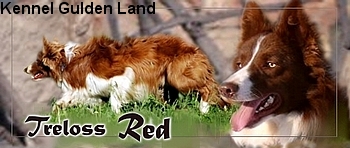
Border Collie
Border Collie
The Border Collies enjoy a privileged position in the world of dog breeds. Everyone talks in superlatives about this breed and the Border Collies are said to be the most intelligent and the best sheepdogs worldwide. The breed distinguishes by its speed and ability to learn easily and quickly and by close relation to its leader, who the dog always maintains eye contact with and fulfils all his/her wishes with pleasure.
In the region between England and Scotland (Border country), there have always been favourable conditions for sheep grazing and people have used sheepdogs since time out of mind. And most probably this breed was developed in this region.
This breed is characteristic by „fixing to hypnotic"gaze through which the Border Collies keep the stock under control. Interesting is the crouched down position of its body with head stretched forward and held down (a motion like crawling).
Border Collies learn really very quickly, are intelligent, submissive and accommodating to the wishes of its owner. They are considered to be number one not only as working dog for farmers, but also in many dog sports, beginning from agility via frisbee up to dog dancing, where they often take the first place.
.
Genetics of coat colour in Border Collies
The basic colour of Border Collies is black and white, brown and white (up to reddish and white) and true red, see tables.
Presence or carrier of tan marking
Presence or carrier of tan marking is caused by ASIP-gene (Locus A), particularly allel at. The allel at is responsible for the phenotypic colour black and tan (tricolor, tan). Locus A is influenced by lokus K. Phenotype can not be shown, if a dog has at least one of this allele KB (dominant black allele). Phenotypic colour black and tan can be shown, if a genotype is ky/ky ,ky/kbror kbr/kbr
Here is an example of tricolor border collie:
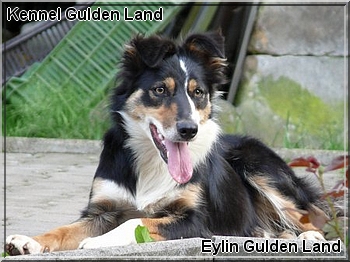
.
Further, grey colour in white parts, so-called "mottled" pattern may also occur. The coat is in white parts overgrown by black hairs and the final effect is grey. The mottled pattern is more distinctive in long-hair coats, on short-hair coat it appears as spots. For this colouring, no genetic examination has been available so far. Here is an example of brown-white-mottled:
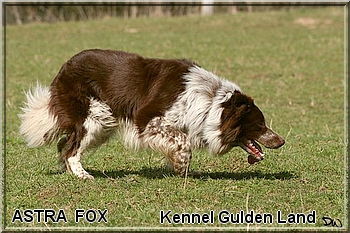
.
The MLPH-gene (locus D) is responsible for the blue and white coat colour that causes dilution of the original black colour to final blue in dogs of homozygous genotype dd. Here is an example of blue merle:
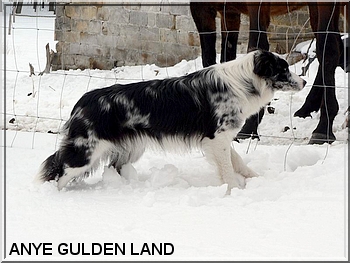
.
Blue and red merle colour is caused by Merle gene that has been identified on the canine chromosome 10 (CFA 10). A Merle dog can be either homozygous with genotype MM or heterozygous with a genotype Mm. The Merle mutation affects not only the coat colour, but also modifies eye colour and colouring on the nose and paw pads. The merle mutation in dogs often changes dark eyes into light or blue. In connection with the merle mutation vision and hearing defects may often occur. For more information see separate article dealing with merle.
Slate merle coat colour is caused by dilution of blue merle, i.e. presence of merle mutation together with the homozygous genotype dd (Locus D). A dog with slate merle is born, if one parent was merle heterozygote Mm or homozygote MM and both parents had at least one allel d.
Sable merle coat colour is caused by the effect of ASIP gene (Lokus A), particularly the allel ay together with the presence of genotype MM or Mm (Merle-gene).
A dog with diluted sable merle colouring has moreover the genotype dd (Locus D).
.
1) black and white, black and white with tan, black and white/ mottled, black and white with Tan / mottled, blue and white, blue and white with tan, blue merle, blue merle with tan, slate merle, slate merle with tan
|
Genotype |
Coat color / Nose color |
Transmission of coat color |
|
EEBB |
black, bicolor, tricolor, blue merle / black |
- |
|
EeBB |
black, bicolor, tricolor, blue merle / black |
red |
|
EEBb |
black, bicolor, tricolor, blue merle / black |
brown |
|
EeBb |
black, bicolor, tricolor, blue merle / black |
red and brown |
Example of black bicolor:
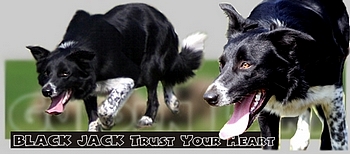
.
2) brown and white, brown and white with tan, brown and white/ mottled, brown and white with Tan / mottled, lila and white, lila and white with tan, lila merle, lila merle with tan
|
Genotype |
Coat color / Nose color |
Transmission of coat color |
|
EEbb |
brown, bicolor, tricolor, merle / brown |
- |
|
Eebb |
brown, bicolor, tricolor, merle / brown |
red |
.
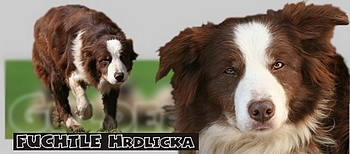
.
3) red, red and white, red merle
|
Genotype |
Coat color / Nose color |
Transmission of coat color |
|
eeBB |
red, red and white, red merle / black |
- |
|
eeBb |
red, red and white, red merle / black |
brown |
|
eebb |
red, red and white, red merle / brown |
- |
.
